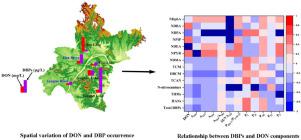Water Research ( IF 11.4 ) Pub Date : 2021-04-11 , DOI: 10.1016/j.watres.2021.117138 Leyun Wang 1 , Xian Zhang 1 , Shanshan Chen 1 , Fanbin Meng 1 , Dayi Zhang 1 , Yi Liu 1 , Miao Li 1 , Xiang Liu 1 , Xia Huang 1 , Jiuhui Qu 1

|
Intensified sanitization practices during the recent coronavirus disease-2019 (COVID-19) led to the release of chlorine-based disinfectants in surface water, potentially triggering the formation of disinfection byproducts (DBPs) in the presence of dissolved organic nitrogen (DON). Thus, a comprehensive investigation of DON's spatial distribution and its association with DBP occurrence in the surface water is urgently needed. In this study, a total of 51 water samples were collected from two rivers and four lakes in May 2020 in Wuhan to explore the regional variation of nitrogen (N) species, DON's compositional characteristics, and the three classes of DBP occurrence. In lakes, 53.0% to 86.3% of N existed as DON, with its concentration varying between 0.3–4.0 mg N/L. In contrast, NO3−-N was the dominant N species in rivers. Spectral analysis revealed that DON in the lakes contained higher humic and fulvic materials with higher A254, A253/A203, SUVA254, and PIII+IV/PI+II+V ratios, while rivers had higher levels of hydrophilic compounds. Trihalomethanes (THMs) were the most prevalent DBPs in the surface waters, followed by N-nitrosamines and haloacetonitriles (HANs). The levels of N-nitrosamines (23.1–97.4 ng/L) increased significantly after the outbreak of the COVID-19 pandemic. Excessive DON in the surface waters was responsible for the formation of N-nitrosamines. This study confirmed that the presence of DON in surface water could result in DBP formation, especially N-nitrosamines, when disinfectants were discharged into surface water during the COVID-19 pandemic.
中文翻译:

武汉地表水中溶解有机氮的空间变化:与 COVID-19 大流行期间消毒副产物发生的相关性
在最近的 2019 年冠状病毒病 (COVID-19) 期间强化消毒措施导致地表水中释放出氯基消毒剂,在溶解的有机氮 (DON) 存在的情况下可能引发消毒副产物 (DBP) 的形成。因此,迫切需要全面研究 DON 的空间分布及其与地表水中 DBP 发生的关系。本研究于2020年5月在武汉市的两条河流和四个湖泊共采集了51个水样,以探讨氮(N)物种的区域变化、DON的组成特征以及三类DBP的发生。在湖泊中,53.0% 至 86.3% 的 N 以呕吐毒素的形式存在,其浓度在 0.3–4.0 mg N/L 之间变化。相反,NO 3 --N 是河流中的优势氮种。光谱分析表明,湖泊中的 DON 含有较高的腐殖质和富里酸物质,具有较高的 A 254、A 253 /A 203、 SUVA 254和 P III+IV /P I+II+V比率,而河流具有更高水平的亲水化合物。三卤甲烷 (THM) 是地表水中最普遍的 DBP,其次是 N-亚硝胺和卤代乙腈 (HAN)。在 COVID-19 大流行爆发后,N-亚硝胺的水平 (23.1–97.4 ng/L) 显着增加。地表水中过量的呕吐毒素是导致 N-亚硝胺形成的原因。这项研究证实,在 COVID-19 大流行期间,当消毒剂被排放到地表水中时,地表水中存在呕吐毒素可能会导致 DBP 的形成,尤其是 N-亚硝胺。











































 京公网安备 11010802027423号
京公网安备 11010802027423号